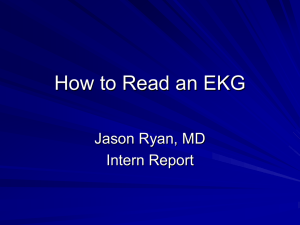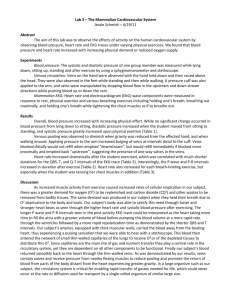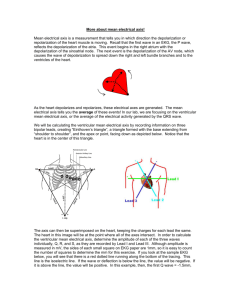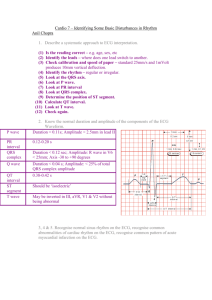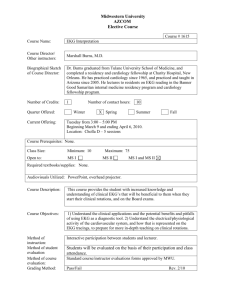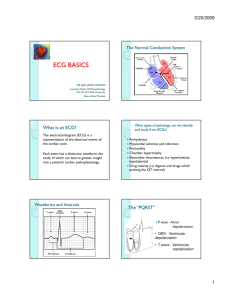University of Puerto Rico School of Medicine
advertisement
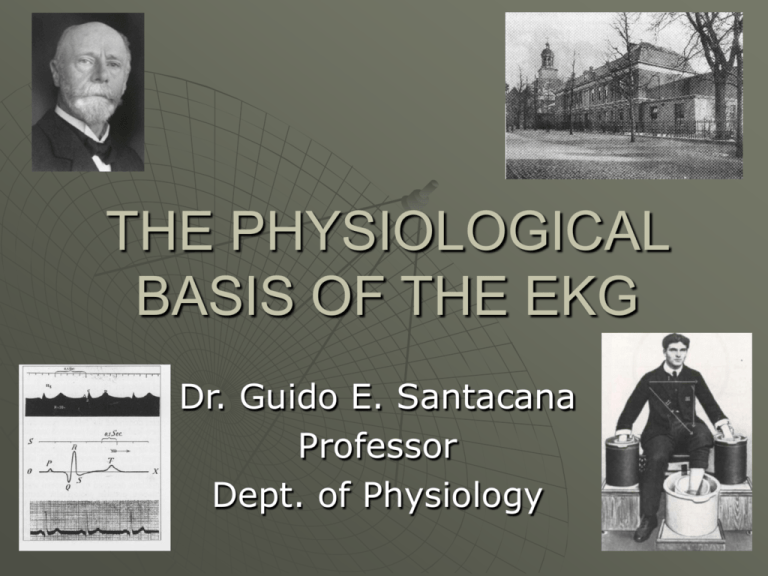
THE PHYSIOLOGICAL BASIS OF THE EKG Dr. Guido E. Santacana Professor Dept. of Physiology After this section you should be able to: Differentiate between an intracellular action potential and the electrocardiogram as an extracellular recording. Recognize the concept of the dipole and electrical potential vector and how it applies to the heart and EKG recording. Recognize that the cumulative electrical activity of the heart forms dipoles or electrical potential vectors in different directions as the activation of the heart progresses. Recognize that the multiple dipoles or electrical potential vectors generated by the heart produce the EKG recording. Learn the 12 EKG Leads and their projection of the lead vectors in three orthogonal planes. Understand how each EKG wave is generated using Lead I as an example. Perform a simple sequential analysis of the EKG. Learn the standards of the EKG recording paper. Understand the origin of the Mean QRS Axis concept. Using the Electrical Axis Circle of the heart learn to estimate Mean Electrical Axis. Calculate the Mean QRS Axis by vector analysis using three or two standard leads. Recognize the effect of left or right hypertrophy on the Mean QRS Axis. Recognize the effect of left or right Bundle Branch Block on the Mean Electrical Axis. Understand the concept of current of injury and its clinical implications. Learn to estimate the site of an ischemic injury using the concept of the J Point. The Conduction System of the Heart Action Potentials = Change in membrane potential occurring in nerve, muscle, heart and other cells The ECG is not an action potential but reflects their cumulative effect at the level of the skin where the recording electrodes are located. THE DIPOLE CONCEPT METER C 0 +2 + JAR -2 B - - + A D POS NEG BATTERY EINTHOVEN’S TRIANGLE AND LIMB LEADS B B A A Einthoven’s Original EKG Recorder String Galvanometer Based EKG Recorder. Patient with hands submerged in strong salt solution. String Galvanometer Schematic. What are we looking at in the EKG waves? VOLTAGE!! As amplitude in Millivolts. Baseline at 0mv TIME!! Duration in fractions of a second Atrial Depolarization P wave (Lead I) A B Zero potential - P + + 0 Peak Potential Ventricular Conducting System AV Node Bundle of His Left Bundle Branch Right Bundle Branch Left Posterior Fascicle P Septal fascicle P Left Anterior Fascicle P= Purkinje Fibers Ventricular Septal Depolarization- the Q Wave A B + + - 0 Q - Ventricular Depolarization-the R Wave B A - R 3 4 + 0 + - Ventricular Depolarization-The S Wave B. A B. + + 0 A S QRS Configurations RSR’ QRS RS QR QS Ventricular Repolarization- the T Wave + B A - T + + 0 - S Review of the Sequence in the Formation of the EKG Intervals and Segments of the Normal EKG INTERVALS AND SEGMENTS ! PR Interval- Onset of P wave to onset of QRS. (.12-.20sec or 35 small squares) QRS Interval-Beginning and end of QRS wave.(<.12sec duration or 3 small squares) QT interval- Beginning of QRS to end of T wave.( Calculated as corrected QT = .42 sec) ST segment ( no elevation or depression) B A 0° Limb Leads=Frontal Plane B 60° B 120° A A + A +A -150° B - -B B 90° -30° A Chest Leads = Horizontal Plane B A + The Chest or Precordial Leads V6 V5 V1 V2 Over right ventricle V3 Over the Left Ventricle V4 Over Interventricular Septum Projection of the 12 Lead EKG Vectors in Three Orthogonal Planes Review of what each EKG Lead looks at. Y Z X Anterior Leads V1,V2,V3,V4 Inferior Leads II,III,AVF Left lateral Leads I, AVL,V5 V6 MEAN QRS AXIS BASICS WHAT IS THE MEAN QRS AXIS? IT REPRESENTS THE AVERAGE DIRECTION OF THE INSTANTANEOUS FORCES GENERATED DURING THE SEQUENCE OF VENTRICULAR DEPOLARIZATION. NORMAL RANGE= -30 TO +90 DEGREES NORMAL VALUE= 59 DEGREES MORE - THAN -30 = LEFT AXIS DEVIATION MORE + THAN +90 = RIGHT AXIS DEVIATION Instantaneous and Mean Vectors of Ventricular Depolarization -90° 180° G F E A B C D Mean Vector +90° 0° The Electrical Axis Circle Where does it come from? Lead I Lead I 0° Lead II Lead III Lead III Lead 120° II REMEMBER EINTHOVEN 60° The three Leads with a Common Center Lead I 0° Lead III 120° Lead II 60° THE ELECTRICAL AXIS CIRCLE! -120° -90° -60° aVR- -150° aVL - -30° +180° I- 0° Normal +150° Range III- +120° +30° II - +60° aVF- + 90° Using the Circle to Estimate MEA TO ESTIMATE QRS AXIS -90° Lead II QRS UP -30° I-0° +180° Lead I QRS UP +150° II - +60° +90° -30° NORMAL AXIS +90° The Isoelectric QRS and its use! aVL -30° +60 Lead perpendicular to the isoelectric QRS II Why is a Wave Biphasic? Cardiac Muscle -----------------++++++++++ Lead - 0 C B A + Meter Cardiac Muscle ++++ ---------------- +++++ Lead - 0 + Meter Cardiac Muscle ---------+++++ - 0 ++++ ------Lead + Meter Electrode Perpendicular to Direction of Depolarization Why is Lead aVL Biphasic? + Lead aVL LA RA - + LV RV Lead I + + Lead II Quick Estimation of Axis Deviation I I AVF Extreme Right axis deviation AVF Left axis deviation 0° Lead I Right axis deviation. Normal axis I I AVF AVF +90° Lead AVF Ventricular Hypertrophy 1 Limb Leads Precordial Leads Ventricular Hypertrophy 2 Precordials S wave R exceeding 18mm R exceeding 26mm Review of Vectors and Vectorial Analysis of the EKG Guido E. Santacana Ph.D. Professor Department of Physiology Basis for Vectorial Analysis The Boat example!!! Actual Direction (Resultant Vector) Graphical Representation y Wind 10 knots x 20 knots Vectorial Analysis of the Mean Electrical Axis EKG (LEAD I): Projected Vectors for different Mean Electrical Axes Tilted Mean Vectors Partial Voltage Reading - + Parallel Mean Vectors LEAD I Higher Voltage Reading - Perpendicular Mean Vectors - No Voltage Reading + LEAD I NO PROJECTED VECTOR!!!!! LEAD I + The Concept of the Projected Vector A=Mean Vector B=Projected Vector Figure A Figure B Projected Vectors for theThree Standard Leads Ventricular Depolarization Analysis Using the Projected Vectors .01 sec .02 sec .05 sec .035 sec .06 sec Ventricular Repolarization Analysis Using the Projected Vectors What is the Vectorcardiogram? It is simply the path marked by the positive ends of The depolarization vectors. How to Plot the Mean Electrical Axis Using Two EKG Leads R wave only = 6mm or .6mv 6mm 6mm Mean Electrical Axis RS waves R= 8mm S= -2mm Total = 8-2=6mm or .6mv Abnormal Ventricular Conditions That Cause Axis Deviation Change in position of the heart in the chest. Hypertrophy of one ventricle. Bundle Branch Block. Vectorial Analysis of Ventricular Hypertrophy -15° Left ventricular hypertrophy in a hypertensive heart. Reasons for deviation are LV mass and conduction time. Vectorial Analysis of Right Ventricular Hypertrophy Notice also the High voltage EKG in Lead I 170° 170° RV Hypertrophy caused by Pulmonary Valve Stenosis Vectorial Analysis in Bundle Branch Block Prolongued QRS due to Slower Conduction Time Through Block -50° left deviation Left axis deviation caused by a Left Bundle Branch Block Vectorial Analysis in Bundle Branch Block Right Bundle Branch Block producing a right axis deviation. Again observe the longer QRS interval. Longer QRS intervals Can distinguish axis deviations due to BBBs vs. hypertrophies. Low Voltage EKG Normal voltage between R wave and S wave should be from .5 to 2mv If the sum of the voltages in the QRS of leads I,II,III is greater than 4mv the EKG is considered as high voltage. Low voltage EKG due to myocardial infarction. Low voltage EKG is also caused by pericardial effusion, pleural effusion and pulmonary emphysema. The Current of Injury Cardiac abnormalities specially those that damage the heart muscle cause part of the heart to remain partially or totally depolarized all the time. The current that flows even between heartbeats from the pathologically depolarized area to the normal area is the CURRENT OF INJURY. Causes of the Current of Injury Mechanical Trauma. Infections Ischemia caused by coronary occlusions. (Most common cause) The Current of Injury Current of injury remains after the heart has Repolarized. EKG Generation in Normal vs. Infarcted Heart NORMAL INFARCTED The J Point and the Current of Injury Vector Analysis J Point is the zero potential line from which the direction of the injury current is determined Injury Potential in Anterior Wall Infarction Respective J Points In Leads I and III J point in V2 an anterior Lead Injury Potential in Posterior Wall Apical Infarction J Points of Leads II & III. J point of V2 Cardiac Arrhythmias Result from disturbances of IMPULSE PROPAGATION IMPULSE INITIATION Conduction Blocks Reentry rhythms SA Node Ectopic Foci Alteration of SA Rhythm Autonomic nervous system usually involved. P, QRS, T waves normal. Duration of Cardiac Cycle P-P interval shortened or prolonged. Sinus Bradycardia- Slow Rhythm. Sinus Tachycardia- Fast Rhythm. Cardiac frequency changes gradually. Bradycardia Normal Rhythm Bradycardia bradycardia occurs when the hearts rate is slower than 60 beats per minute. Tachycardia Normal Rhythm Tachycardia Sinus tachycardia occurs when the sinus rhythm is faster than 100 beats per minute AV Transmission Blocks Impulse transmission through conduction tissue blocked. His Bundle Electrogram may be used to localize block. His Bundle Electrogram Prolongation of either the A-H or H-V interval indicates block above or below the Bundle of His A Atrial Wave H His Bundle Wave V Ventricular wave Paroxysmal Tachycardia Abrupt onset and termination. Origin is ectopic site. Reentry circus movements most frequent cause. High frequency. Can cause lightheadedness or syncope. Rapid contractions reduce ventricular filling. Paroxysmal Supraventricular Tachycardia Originate in atria or AV tissue. Usually from a reentry loop in atrial, AV tissue or both. Paroxysmal Ventricular Tachycardia From ectopic foci in the ventricles. From considerable ischemic damage. Bizarre QRS complexes May be a precursor of Ventricular Fibrillation Results from digitalis toxicity. Fibrillation Arrhythmia that is ineffectual in pumping blood. Atria or Ventricles may be involved. Is due to fragmentation of reentry loop into multiple irregular circuits. Atrial Fibrillation Atria do not contract and relax sequentially. No contribution to ventricular filling. No P waves. Irregular fluctuations or f waves. Normal QRS complexes but irregular rhythm. Compatible with life and full physical activity. 20-30% reduction in ventricular pumping. Ventricular Fibrillation Irregular continuous twitching of the ventricular muscle. No pumping of blood possible. Loss of conciousness occurs rapidly Irregular fluctuations in the EKG Often initiated by a premature impulse arriving in the vulnerable phase. Vulnerable phase coincides with downslope of the T wave. Electric shock used to treat VF by leaving the ventricles temporarily refractory and allowing the SA node to take over again. Mechanism of Ventricular Fibrillation Causes of reentry Circus movements Long Pathway= dilated hearts Decreased velocity of conduction=blockade of Purkinje System Greatly shortened refractory period= Epinephrine 60 Hz AC Induced VF 60Hz 120VAC Applied here End result Atrial Flutter F wave Normal EKG Wolf Parkinson-White Syndrome Normal Wolf Parkinson White Alternate Conduction Pathway Bundle of Kent SEQUENTIAL APPROACH TO THE EKG Gain familiarity with the normal EKG. Evaluate the rhythm. Calculate rate. Evaluate each P wave, QRS, ST segment and T wave in each lead. Mean QRS Axis Abnormalities of the P wave Abnormalities of the QRS ST and T wave abnormalities. The Normal EKG - 12 lead Reading the EKG Paper BASICS Each individual horizontal and vertical line is ruled in 1 mm Each horizontal space represent a time interval of 0.04 sec Each vertical space represents a voltage change of 0.1 mv 0.5 mv 0.2 sec. HEART RHYTHM Every P wave followed by a QRS. Every QRS preceded by a P wave P wave upright in leads I, II, III PR interval greater than .12 sec P wave rate 60-100BPM with < 10% variation. < 60 - sinus bradycardia, >100sinus tachycardia. Variation of more than 10% = Sinus arrhythmia CALCULATE HEART RATE STANDARD EKG PAPER SPEED OF 25MM SEC HEART RATE = 25MM SEC X 60SEC/MIN MM/BEAT OR!! = 1500 # of small boxes between 2 beats Example 23 There are 23 mm between the two QRS complexes, therefore: Heart rate = 1500/23 = 65 beats/min Analyzing The Normal EKG Left Atrial Enlargement Right Atrial Enlargement Sample Abnormality of the P wave MITRAL STENOSIS P waves not visible random rhythm right ventricular hypertrophy atrial fibrillation AV BLOCK Exercise Intolerance Ventricular Escape Rythm Hyperkalemia Small or absent P waves Atrial Fibrillation Wide QRS Shortened or absent ST segment Wide and tall T waves Ventricular fibrillation (sometimes) Haemodialysis Hypokalemia Small or absent T waves 1st or 2nd degree heart AV block slight depression of ST segment Vomiting (prolonged)


